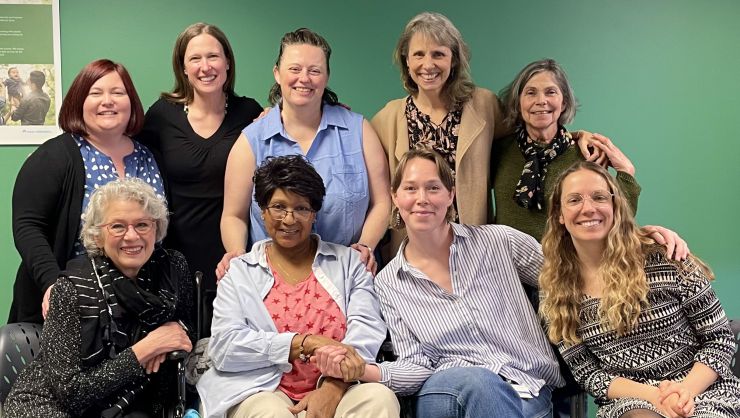Improving pain care by restoring patient-clinician trust

Coauthors on the ACT Center’s latest paper (L-R): Claire Allen, Marina Peck, and Paula Lozano
New ACT Center paper explores how health systems can improve opioid prescribing safety with patient-centered care
Over the last decade, prescription opioids have caused more than 14,000 deaths per year in the United States. Kaiser Permanente is one of hundreds of health care organizations nationwide working to reverse this alarming trend by following stricter, evidence-based opioid prescribing guidelines from the Centers for Disease Control and Prevention (CDC). These new guidelines have created tension in many patient-clinician relationships — as clinicians are asked to reduce opioid prescribing even though many patients perceive opioids as a key part of managing their ongoing pain.
Since 2019, the Center for Accelerating Care Transformation (ACT Center) at Kaiser Permanente Washington has been working alongside patients and clinicians to design, implement, and evaluate a new approach to providing long-term pain care. Based in primary care, the Integrated Pain Management (IPM) Program was built to improve the safety of prescription opioids while still providing whole-person care for people who live with ongoing pain.
Along the way, the IPM team has shared many important tools and insights to help patients, clinicians, and health systems everywhere learn from their experiences — including a pain management toolkit written by and for people with persistent pain. Their latest contribution is a paper recently published in The Journal of Pain that explores how health systems and clinicians can rebuild trusting patient-clinician relationships, provide patient-centered pain care, and include patient perspectives in opioid safety processes.
Rebuilding trusting relationships to improve opioid safety
Led by ACT Center Director Paula Lozano, MD, MPH, the paper highlights how the erosion of trust between patients and clinicians is a crucial but often overlooked part of the prescription opioid crisis.
“People who live with ongoing pain and rely on opioid medications to manage their daily lives often feel stigmatized and frustrated when their care goals don’t align with the stricter prescribing guidelines clinicians nationwide are being asked to implement,” explained Lozano. “At the same time, clinicians are under pressure to deprescribe opioids and to aggressively monitor for problems like opioid use disorder. This tension can undermine the therapeutic relationship and cause a lack of trust.”
Organizational prescribing rules that are intended to promote opioid safety often stigmatize and alienate the patients they’re trying to help. For example, opioid agreements — sometimes referred to as “contracts” — make access to medications contingent on patient compliance and periodic urine drug screens. Evidence that these agreements are effective is weak, and their language may come across as accusatory or confrontational. This can lead to a patient-clinician relationship that feels combative and coercive rather than trusting and collaborative.
Lozano’s coauthors include Kathleen (Kat) Barnes, MD, MPH, a Kaiser Permanente Washington family physician, and Marina Peck, a Kaiser Permanente Washington member with lived experience managing persistent pain. Their team combined patient and clinician perspectives with an evidence review to explore ways to rebuild trusting relationships centered on patients’ needs.
“We approached this paper as a conversation between a patient and a clinician, in which each had their say. Listening to another’s perspective is at the heart of empathy, so in a way, this paper was a meta-exercise in empathy,” said Lozano. “Giving space for both perspectives felt like the equitable way to talk about how the patient-clinician relationship has suffered as a result of opioid prescribing. That’s rarely done in the scientific literature, so it felt exciting and hopeful.”
What challenges do patients face?
From the patient perspective, it’s important to know what to expect from pain care visits and to work in partnership with clinicians to make treatment decisions. The paper includes insights and patient stories that illustrate key moments that can make or break the therapeutic relationship — for example, being suddenly asked to provide a urine sample:
“One day my doctor’s office notified me that I needed to come in to review my pain medication. I immediately began to worry, ‘Have I done something wrong?’ Upon arrival, they handed me a cup for a urine sample. This had never happened before. I started thinking anxiously, ‘I really must have done something wrong. They are going to take away my pain medication.’” — patient quote from paper
Importantly, the clinician in this situation acknowledged that the request for a urine sample was a surprise. She allowed extra time for questions and discussion, reminding the patient that they would make treatment decisions together and reading aloud the medication review notes she was adding to the patient’s medical record.
“Years later, I still think back on this moment; a moment when trust could be built or destroyed. My clinician chose to show me my experience was important to her, worthy of the extra time and care she gave me that day. She communicated ‘No decision about me, without me’ not only in word, but perhaps even more importantly, in action.” — patient quote from paper
What challenges do clinicians face?
Clinicians face many barriers related to long-term opioid prescribing that make it difficult to cultivate a healing and empathic relationship with patients. With national and institutional guidelines requiring them to systematically reduce opioid doses, clinicians are put between a rock and a hard place when it comes to balancing these guidelines with individual patient circumstances.
Consider, for example, a patient with ongoing pain who is required to have frequent in-person medication check-ins, even when their non-opioid care options and ability to travel to the clinic are limited:
“Transportation, technological, and financial barriers have impacted [this patient’s] ability to comply with a new health system safety initiative that requires in-person or video visits at least every 3 months for patients on long-term opioids. … Our more frequent visits are intended to have us explore alternatives to opioids for his pain, but instead can feel absurd, as accessing a service like acupuncture or cognitive behavioral therapy is unattainable for him from a cost and logistics perspective. Meanwhile, if [he] is past due for an appointment and requests a refill of his long-term opioids, I receive a message from health system leaders advising that I decrease the supply of his medications and consider tapering.” — clinician quote from paper
Recommendations for rebuilding patient-clinician trust
Based on these perspectives, Lozano and colleagues concluded that implementing prescribing guidelines in a patient-centered way is essential to improving opioid safety.
“Solving the opioid crisis will require solutions that directly incorporate patient perspectives and increase patient participation in treatment decisions,” said Lozano. “To deliver care that is both evidence-based and patient-centered, health care organizations must create the expectation that all staff will deliver recommended care while also adapting to the unique needs and circumstances of each patient.”
This viewpoint aligns with new opioid prescribing guidelines released by the CDC in November 2022. Based on input from patients, caregivers, and clinicians, the updated guidelines emphasize the importance of creating flexible, individualized care plans while enhancing patient-clinician communication and patient-centered decision-making.
To this end, the paper offers specific recommendations to help health systems implement evidence-based prescribing guidelines while also taking meaningful steps to restore trust between patients and clinicians:
- Provide infrastructure support: Health systems should prioritize continuity between patients and their primary care clinicians, accounting for the time needed to co-create pain care plans and opioid taper plans that preserve patient autonomy when possible. Providing training for clinicians to hone their skills in empathic communication is also essential.
- Provide access to resources: Reducing opioid prescribing will require health systems to invest in evidence-based alternatives for pain care — such as pain self-management classes, cognitive behavioral therapy for persistent pain, education on whole-person pain care, and treatments such as physical therapy, massage, acupuncture, and chiropractic care.
“Our experience on IPM has taught us that when clinicians and patients have time to focus on building a trusting relationship, it paves the way for them to work collaboratively to chart a course for improved opioid safety and patient wellbeing,” concluded Lozano. “In this paper, we had an opportunity to turn an often-polarized conversation into an open, candid dialogue. We all worked hard to keep the conversation constructive, to show curiosity, and to learn from Marina’s and Kat’s lived experiences. And I’m excited to share what we learned with others.”
Read the paper “Persistent pain, long-term opioids, and restoring trust in the patient-clinician relationship,” in the February 2025 issue of The Journal of Pain. Lozano’s coauthors are Claire Allen, MPH; Kathleen Barnes MD, MPH; Marina Peck, MFT; and Jessica Mogk, MPH.
By Jessica Ridpath
Related news



